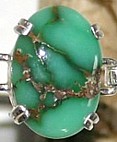
Treatment of Diamond Gems

 |
Treatment of Diamond Gems
|
 |
Because
of its high value, diamond is subject to a number of treatments to improve its appearance. These include irradiation, heating as well as
techniques to fill cracks and other open space voids within the gem. Irradiation
is commonly used to alter the color diamonds, usually to produce gems with more desirable
colors in hues of blue green brown orange a very dark green and also yellow colors. These
colors are normally produced from off-color stones in undesirable shades. A wide variety of techniques are used including
bombardment with beta particles (high energy electrons), neutrons, protons and alpha
particles are used to affect the color change. Most diamonds which are irradiated to
change the stone’s color have been treated by exposure to either beta particles or
neutrons. Both processes induce a blue to
blue-green color depending on the material in the treatment circumstances. Because these forms of radiation penetrate deeply
into the stone, they tend to produce more uniform stone coloration. The colors so produced
are deep and well saturated, but also quite stable under normal jewelry use. Not all stones respond in exactly the same manner
and at times unexpected colors are produced. Heating
is widely used to modify the colors produced by a radiation treatment for heating the
change a coloration generally goes from a blue to green and from the green to brown
finally to yellow and eventually back to the original color depending on the background
natural coloration of the stone and the conditions used the operator treating the stone
may choose to stop the process when a desirable shade of coloration has been produced. Most diamonds which have been irradiated receive
at least some heat treatment in order to refine the color and produce the most desirable
shade possible. Because the shades of diamond produced through radiation and heat
treatment are generally not similar to natural diamond colors, disclosure of such
treatment should always be made to the buyer. |
|
Processes
to improve stones which contain inclusions, cracks, voids and other flaws have been
greatly refined in the last few decades. There are several operators performing this
process, perhaps the best-known is the Yehuda diamond treatment technique. Lasers are used
to drill down into inclusions after the stone has been cut and polished. Through the laser
drill hole, acids or other chemicals may be used to dissolve away the inclusion leaving a
void. The holes in the stone are extremely tiny smaller than one 1000th of an inch in
diameter. Various glass-like materials are
then put in to the stone through the laser drill hole to fill any voids, cracks or other
openings within the stone. These sorts of
treatments can greatly improve the visual appearance of the stone. As a result, one is
able to purchase a gem diamond which appears to be of very fine quality for small fraction
of the price one would normally pay for such a stone. This would appear to be a very
important economic advantage. Unfortunately,
the glass materials used to fill the voids are not nearly as strong or stable as the
diamond. Stones which were weak through the
presence of cracks and other flaws do not become appreciably stronger through the process
of filling them with a glass material, and any structural weakness that was originally
present still remains. As a result, these
stones are far more subject than one would expect to damage the impact or other blows
while being worn, especially when used for wedding rings. In addition, such stones can be
damaged by jewelers during jewelry repair if they are not aware of the treatment. Treated
stones will not stand up to the heat during normal jewelry repair that a normal diamond
would easily endure. Treatment by laser
drilling must always be disclosed to the buyer, without exception. Failure to notify and
explain both the advantages and disadvantages to the buyer before purchase is nothing more
than fraud. The presence of such a treatment
is not difficult to detect for jeweler with the proper tools for gem analysis. Often the trained eye can see what are called
rainbow flashes which come off the filling glass material when it is turned to specific
angles from the viewer. |
|
|
Want to know a little bit more about this crazy prospector guy? Well, here's a little bit more about me, and how I got into prospecting: Chris' Prospecting Story